New Delhi. US space agency NASA has released the second picture of the famous ‘Pillars of Creation’ taken by the new super space telescope James Webb. This week we get a rendering of the active star forming region as seen by Webb’s Mid Infrared Instrument ‘MIRI’. Last week there was the Near Infrared Camera ‘NIRCam’, which was uncovering this remarkable spot at a distance of about 6,500 light years from Earth.
What’s interesting about the new picture is the choice of wavelengths used to display the pillars. At the center of the pillars are what astronomers call Messier 16 ‘M16’ or the Eagle Nebula. They are the subject of intensive study. Each great telescope is directed in their direction to try to understand the physics and chemistry as new stars are born in large clouds of gas and dust.
Webb is the latest largest and best space observatory to take in the scene with its 6.5 meter wide mirror and high sensor. What’s interesting about the new MIRI picture is the choice of wavelengths used to display the pillars. Usually astronomers can filter the light to make the dusty columns too translucent, so that their inner newborn stars can be seen in greater detail. That’s what the ‘NIR CAM’ image did. This emphasized the thousands of young blue stars that exist.
And MIRI has been able to take this approach to another step, but on this occasion filtering has selected the wavelengths at which the dust actually shines. Defying expectations lets you see through the dust. This stunning image shows that they are also great for studying the complex molecules made up of dust and the intense light of nearby hot stars.
 Indian Thought Latest News & Views
Indian Thought Latest News & Views



